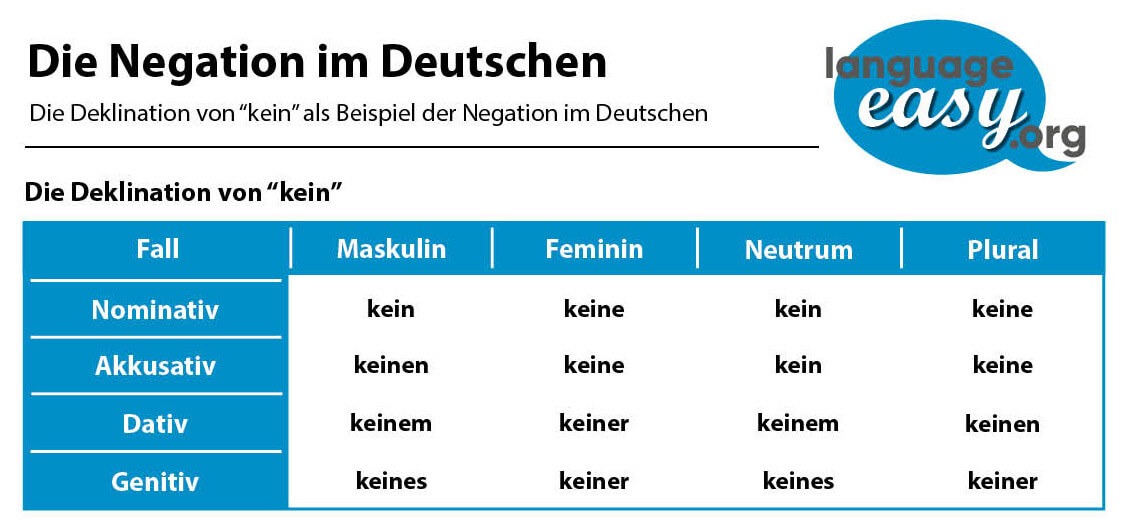German Negation
Die Negation im Deutschen – Erklärungen und Beispiele
German Negation – Summary
Zusammenfassung
The Negation with “nicht”
You use “nicht” for negation in the following circumstances:
- for verbs (normally, “nicht” is put at the end of the sentence when negating simple verbs. When negating a compound noun, it’s put in front of the main verb.)
“Er isst nicht.” – “Er hat gestern Nacht nicht gegessen.” - for nouns with definite articles of possessive pronouns (“nicht” is put in front of the definite article)
“Er hat nicht das Futter bezahlt, sondern das Halsband.” - for names (“nicht” is put in front of the name)
“Das ist nicht Philips Hund, sondern Julians.” - for pronouns (“nicht” is front of the pronoun)
“Ich habe nicht dich angeschrieben, sondern Philip.” - for adjectives (“nicht” is put in front of the adjective)
“Das ist nicht gerecht!” - for adverbs (“nicht” is put in front of the adverb)
“Er isst nicht gerne Kuchen.” - for place, time and manner (“nicht” is put in front of the preposition, which are used for indicating place, time or manner)
The Negation with “kein”
You use “kein” in the following cases:
- for nouns without article
“Ich habe Angst.” – “Ich habe keinen Angst.” - instead of an indefinite article
“Das ist ein Hund.” – “Das ist kein Hund.”
“Nein, ich will kein Deutsch mehr lernen!”
Hopefully, you will never think or say that. Just think of the beautiful German language, its pronunciation, its irregular verbs and exceptions from the grammar rules and…
No, I hope that you know that its just a joke! Of course, German is a beautiful language, and it is the entrance the to a whole new world full of new people and culture.
But, I just needed something to introduce the topic of this article, the German negation. So, as you have clicked on this page of language-easy.org, I suppose that you are ready to enter this depth of German grammar. Well, the German negation is actually not too complicated. Although, there are some parts that do not exist in this form in the English language – and these are the parts where you simply have to study hard.
So, what is the German negation? In the following I’d like to give you a short definition of this term in German grammar. Furthermore, we will talk about the correct usage of German negation and its different negation phrases.
What’s the German Negation?
Well, as already mentioned, we should clear up what the German negation actually is. So, please try to keep in mind the following ‘definition’.
The German negation or negatives sentences are formed with the word “nicht” (not) and “kein” (no/none).
In the following, we will have a look at the more complicated part of German negation and try the clear up when to use “kein” or “nicht” in a German sentence. Auf geht’s!
The Usage of “Nicht” in German
Die Verwendung des “Nicht” im Deutschen
So, in this section we will talk about the correct usage of the negation word “nicht”. Well, you simply use the word “nicht” to negate sentences in German. Furthermore, the position of “nicht” in a phrase can vary, depending on what part we want to negate or emphasize. In the following, I’d like to list the most common ways of using “nicht” in the correct way.
How and When to Use “kein”
- First, you can use “nicht” in the German negation at the end of a sentence with verbs in simple tenses, like the present or the past tense…
“Philip weint nicht.” – Philip doesn’t cry.
… Whereas in compound tenses like the perfect tense it is before the full verb.
“Philip ist gestern nicht nach Hause gekommen” – Yesterday, Philip hasn’t come home. - Second, “nicht” is put before the definite article or possessive pronoun used with nouns.
“Philip hat nicht nur ein Bier getrunken, sondern viele!” - Third, and very similar to the second point, in front of names or proper nouns.
“Das war nicht Julians Fahrrad, sondern Philips.” - Fourth, you place “nicht” before pronouns.
“Philip hat nicht dich angerufen, sondern Julian.” - Fiths, in front of adjectives.
“Das ist nicht besonders schlau!” - Sixth, you can put it before adverbs.
“Philip lernt nicht gerne.” - Seventh and last, you can put “nicht” before the prepositions with indicators of place, time and manner in a German negation.
“Philip wohnt nicht mehr in Bayern.”
Finally, I’d like to mention that “nicht” almost always come before the word it negates. Well, the only exception is when it negates a verb.
The Usage of “kein” in German
Die Verwendung des “Kein” im Deutschen
Well, this part of the text about German negation is about the correct usage of the word “kein”. So, as “nicht”, we also use “kein” in the negation of a sentence.
- First, we use the word “kein” with nouns that don’t have a article.
“Philip hat kein Fahrrad.” - Second, “kein” is used as a replacement for an indefinite article.
“Das ist kein Hund.”
So, in the following table I’d like to show you the ending for “kein”. Of course, all of have noticed immediately, that the ending are identical with the endings of possessive pronouns.

Now, as we have cleared up nearly everything about the words “nicht” and “kein” in the context of German negation, I’d like to mention a last short point.
The Usage of “nicht” and “kein” with “sondern”
Well, this point is nothing to worry about – but still worth mentioning it. Well, you simply will not get confused in case you want to combine these words with “sondern”: Both of them are valid.
- “Philip mag keine Coca Cola, sondern Wasser.”
- “Philip mag nicht Coca Cola, sondern Wasser.”
The Usage of “doch” after a negative Question
At the end I want you show a small exclusion of saying yes. Normally you allways answer yes in German with “ja”.
- Hast du eine gute Note? Ja ich habe eine gute Note.
- Kommst du heute nach Hause? Ja ich komme nach Hause.
But after a negative question you have to say “doch” if you want to say yes.
- Kommst du heute nicht nach Hause? Doch ich komme nach Hause.
- Hast du heute keinen Durst? Doch ich habe Durst.
Exercises
Übungen
Finally, we have reached the last part of this article where you can prove the German skills you have just learned. In the following you will see some phrases that you should complete with the correct terms. Once you have filled all the gaps, just click on the “correct” button and you can see your errors and the correct results. Good luck and… auf Wiedersehen!



